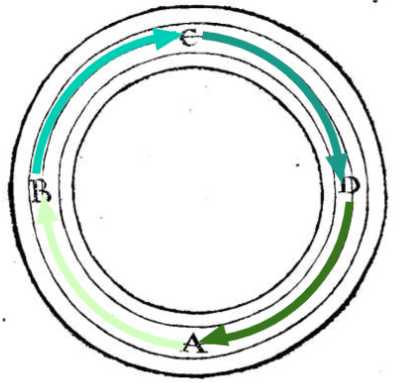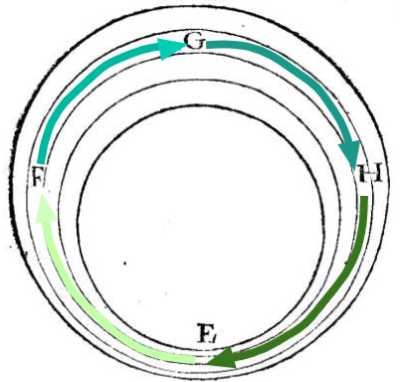There is No Vacuum in Nature
Table of Contents
33. All places are full of bodies
The same parts of matter are always being carried along in every motion, and so bodies are only moved in a circle.
For example, part A is moved towards B, only at the same time that part B is moved towards C, C towards D, and D towards A.

It follows that:
- no body expels another from the place it enters
- the place which has been abandoned by the first enters at the same time as it has been abandoned
This we easily understand in a perfect circle, because we see that no emptiness, no rarefaction, or condensation is required for part A of the circle to move towards B, provided that at the same time part B moves towards C, C towards D, and D towards A.
But the same is true for an imperfect, irregular circle as long as the unevenness of the paths can be compensated for by the unequal speed of the movements.
In this way, the whole mass of material contained in space EFGH can move in a circle without any condensation or emptiness. At the same time:
- its part facing
Ecan pass towardsG - the one which is facing
Gcan pass towardsE.

This is only as long as the space at G is 4 times wider than at E, and twice as wide as at F and H, so that it also moves 4 times faster at E than at G, and twice as fast as at F or `H``.
And so in all the remaining places the speed of movement compensates for the narrowness of the space. In this way, in any given fixed time, the same amount of material will pass through one part of this circle as through another.
34. From this follows the division of matter into really indefinite particles incomprehensible to us.
The matter which already fills space G cannot successively fill all the spaces between G and E which are infinitely smaller. Some part of that matter must adapt its shape to the countless measures of those spaces.
To achieve this, all its innumerable particles must be separated from each other by division.
This leads to the division of certain particles of matter into infinity, or indefinitely.
35. How does this division happen?
I am not speaking about the entire matter, but only about some particles of it.
There might be 2 or 3 particles of it in G, as wide as space E, and also several other smaller ones that remain undivided.
But they move circularly towards E, provided that certain others are mixed with them.
For example, there might be 2 kinds of particles:
- Shape-changers
These bend themselves in various ways and change their shapes.
Superphysics Note
- Speed-changers
These do not change their shapes but change their speed to occupy space accurately.
These 2 jointly fit together and occupy all the space.